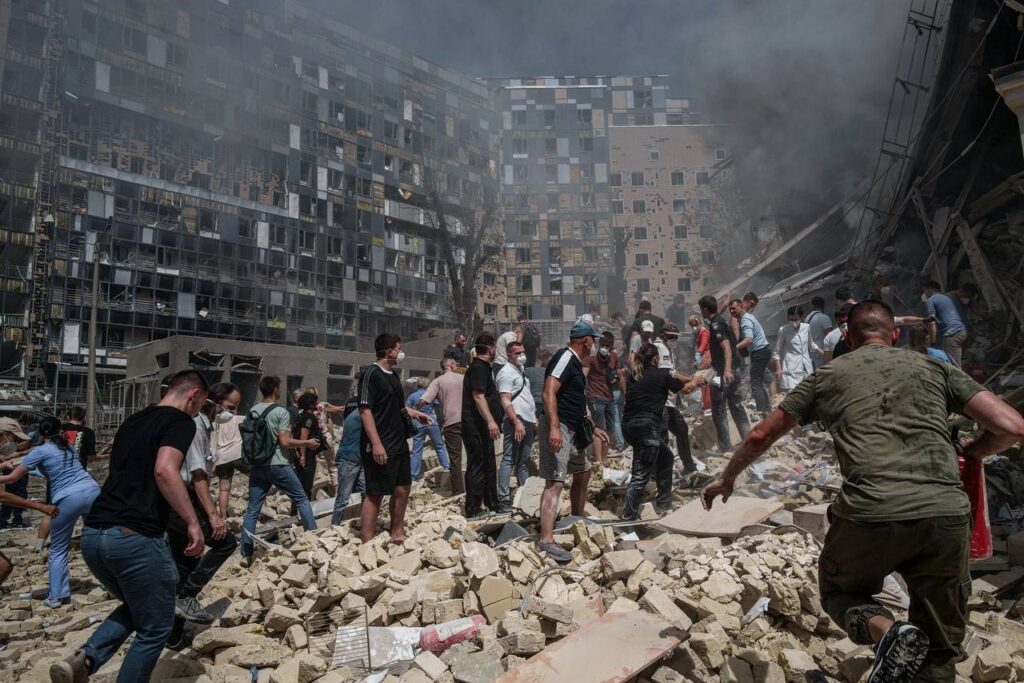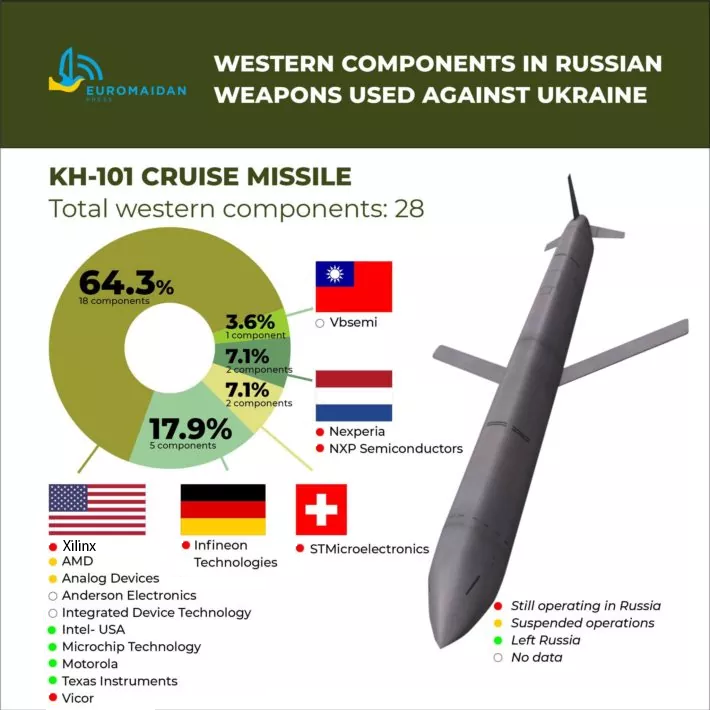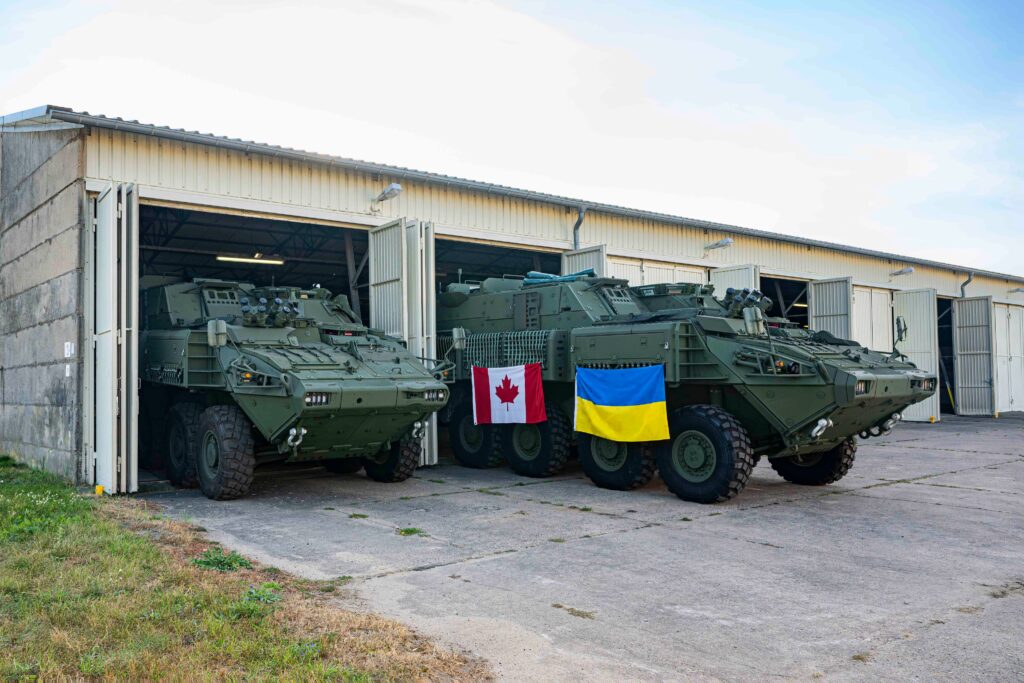Western tech in Russia’s missiles: 15 companies whose parts fuel Kh-101 missile that hit Kyiv Children’s Hospital
The Russian Kh-101 cruise missile that struck Kyiv's children's hospital, killing several, contained 28 components from 15 Western firms, Six of these companies still operate in Russia


It is beyond doubt that the Russian missile that struck Kyiv’s central children’s hospital Okhmatdyt on 8 June was a Kh-101 cruise missile, a highly-accurate weapon
The attack on Ukraine’s number one children’s medical institution killed two medics and injured 50 people. A little boy injured in the attack later died from his wounds.
The Kh-101, Russia’s most advanced tactical land attack cruise missile launched from Tu-95MS strategic bombers, carries 450 kg of explosives and an accuracy of 5-20 meters. Its flight routes are programmed well ahead, meaning that the strike on Okhmatdyt was no accident but a planned Russian war crime.
Back in 2022, the Ukrainian project Trap Aggressor, which exposes the participation of Western and Russian companies in Russia’s war against Ukraine, systematized information from Ukrainian and foreign sources about electronic components discovered in Russian military equipment to provide a more comprehensive picture of this dependency.
It found 39 types of Russian weapons and equipment with foreign processors, modules, and chips by analyzing battlefield evidence in Ukraine. Tanks, airborne combat vehicles, fighter jets, night vision devices, binoculars, and radios are some examples. 69 companies were found to supply components for this equipment to Russia.
This data was then checked against the SelfSanctions database of the Kyiv School of Economics, which provides a comprehensive tally of companies still operating in Russia.
We reported on these findings back in 2022: How to cut off the oxygen to Russia’s war machine.
Following the deadly Russian Kh-101 strike on Kyiv’s Central Children’s Hospital, we revisited the project and updated it with the current information from the KSE database to shed light on the criitical western high-tech components thanks to which Russia continues to build its weapons of death.
Apart from the country, company, and components, we specify whether the company has left Russia, suspended operations, or is continuing operations as usual.
While there have been no sanctions against companies that continue operating in Russia, enterprises that chose to continue business in the aggressor state after the start of its full-scale war against Ukraine on 24 February 2022 have faced pressure to stop paying taxes to the Russian budget. And in our case, possibly supplying critical components to army enterprises.
Western components in the Russian Kh-101 missile
The Kh-101 missile contains at least 28 foreign components, as per Trap Aggressor Research and the KSE database:

- 5 German-made by Infineon Technologies (Cypress Semiconductor) (stayed in Russia): Computer hardware, CMOS static RAM, 32-megabit flash memory chip (SN-99 system), Memory-SRAM, and Memory.
- 18 US components, including:
- 5 by Texas Instruments (left Russia): Shifting bus switch (CBTD16210, Quad differential line receivers (DS26C32ATM CMOS), Integraited circuits, Memory ram chip, Bidirectional transceiver).
- 3 by Analog Devices (along with two by Analog Devices (Linear Technology Corporation)); both have suspended operations but have not fully withdrawn from Russia: Multiprotocol transceiver, 12-bit A/D converter manufactured (SN-99 system), Micropower sampling converter).
- 2 by Integrated Device Technology (no data): 64-bit microprocessor, Schmitt trigger
- 2 by Intel (left Russia): Processor, Microprocessor
- 1 by Advanced Micro Devices (Xilinx) (stayed in Russia): Field-programmable gate array
- 1 by Anderson Electronics (no data): Crystal clock oscillators
- 1 by Microchip Technology (left Russia): Integraited circuits
- 1 by Motorola (left Russia): Voltage regulator
- 1 by Vicor (stayed in Russia): DC-DC converter
- 1 by Zilog (no data): Communications controller
- 2 components manufactured in the Netherlands:
- 1 by NXP Semiconductors (Philips Semiconductor) (stayed in Russia): shifting bus switch
- 1 by Nexperia (stayed in Russia): bus transceiver
- 2 components made in Switzerland by STMicroelectronics (stayed in Russia): Quad flat package and 44-lead thin quad flat packages
- 1 Taiwan-made by Vbsemi (no data): Mosfet
The number of components may be much higher. Research by the Yermak-Mc Faul group on sanctions says that 53 types of foreign-produced Electronic Control Units are inside the Kh-101 missile. However, the Trap Aggressor database contains these 28.
Production speeds of Russian Kh-101 missiles
The Kh-101 missiles Russia hurls into Ukraine’s civilian infrastructure were produced fairly recently.
In December 2022, the Long War journal estimated that Russia produces one Kh-101 missile every four days. The analysts noted that despite Western export controls significantly limiting Russia’s missile production capabilities, Russia compensated by purcasing microcircuits through third countries.
In January 2024, Russia launched a Kh-101 at Kyiv that was produced in Q4 of 2023, according to analysis of its serial number by Defense Express.
In May 2024, Defense Express reported that Russia used a just-produced Kh-101 in its 8 May missile attack. This Kh-101 missile was modified to carry a greater payload: apart from the standard 450 kg, it had a second section with 350 kg of explosives. This doubling of its explosive power came at the price of a decreased range: not 5500 km, but 2250, which is still enough for pummeling Ukrainian cities.
Despite the limitations from Western bans on technology sales to Russia, the aggressor is making nearly eight times more Kh-101s than before its full-blown invasion of Ukraine in 2022, relying on western components, FT reported. The components were repurposed from civilian use, with Russia buying them on the open market and importing via China, FT wrote after analyzing a Kh-101 Russia launched at Ukraine in January 2024.
How do Western components end up in Russian weapons?
After Russia’s invasion of Ukraine in February 2022, the West implemented a series of stringent sanctions aimed at restricting Russia’s access to advanced technologies, including microelectronics. These measures were designed to hinder Russia’s military capabilities and its ability to manufacture advanced weaponry:
- Export Controls: The United States, the European Union, the United Kingdom, Japan, Canada, Taiwan, and other Western countries imposed export controls on microelectronics and other critical technologies. These controls restricted the direct sale of advanced semiconductors and electronic components to Russia.
- Ban on Dual-Use Technologies: Dual-use technologies, which can be used for both civilian and military purposes, were specifically targeted. These included microprocessors, programmable chips, and other electronic components essential for military applications.
Despite these sanctions, Russia managed to circumvent some of these restrictions through global supply chains. Reports indicate that many commodity electronic components, which are widely used in various industrial applications, were not subject to stringent export controls. These components continued to flow into Russia through third-party countries and intermediaries, making enforcement difficult.
According to the Carnegie Endownment, its circumvention tactics include:
- Purchases through third-party countries. Russia leveraged its trade relationships with countries like China, Türkiye, and the UAE to procure restricted technologies. These countries facilitated the transshipment of microelectronics to Russia, bypassing Western sanctions.
- Use of intermediaries. Russian companies utilized a network of intermediaries and shell companies to hide the true destination of their purchases. These intermediaries operated through ports in neutral or friendly countries, enabling the continued flow of essential components to Russia.
- Import of standard components. Many of the electronic components used in Russian military systems are standard products found in civilian applications, such as automotive or consumer electronics. This ubiquity makes it challenging to fully control and restrict their export.
Though Western companies, including major semiconductor manufacturers like AMD, Intel, and Infineon Technologies, have launched internal investigations to ensure compliance with sanctions and to address any potential breaches through their supply chains, the global nature of supply chains and the availability of standard electronic components continue to pose challenges in fully isolating Russia from these critical technologies.
However, there is no excuse for the six companies that continue operations in Russia, potentially selling the parts to Russia’s defense production, and definitely funding its missile attacks on Ukraine by paying taxes to the Russian budget:
- Xilinx
- Vicor
- Infineon Technologies
- STMicroelectronics
- Nexperia
- NXP Semiconductors
Nor can there be, actually, for any other company still doing business in Russia.
Related:
- Russia struck Kyiv children’s hospital with Kh-101 missile, OSINT analysis indicates
- How to cut off the oxygen to Russia’s war machine
- US officials: Beijing provides Moscow with components to boost military production
- EU issues guidance to prevent evasion of sanctions imposed on Russia


